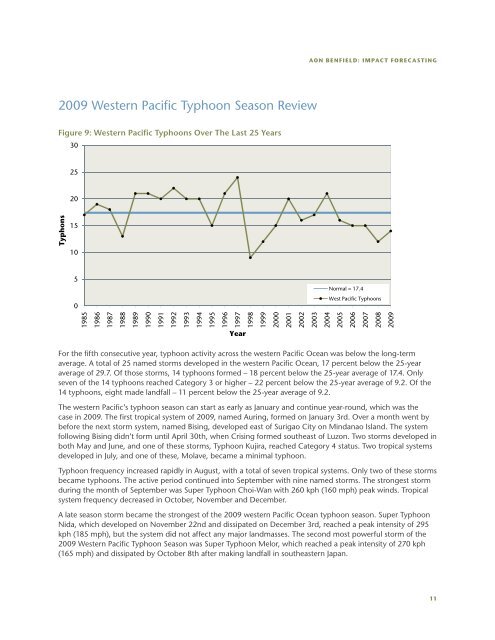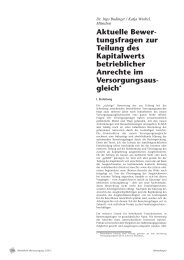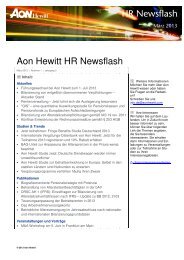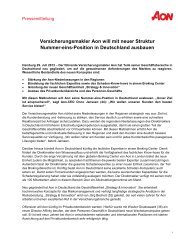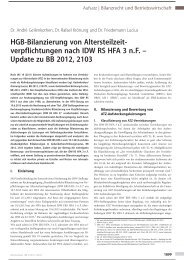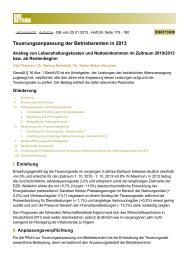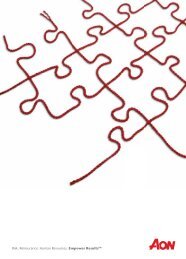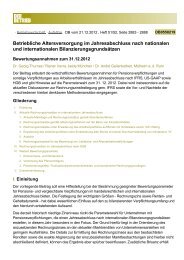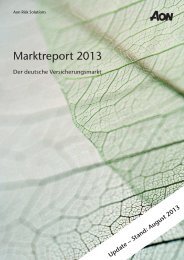Annual Global Climate and Catastrophe Report: Impact ... - Aon
Annual Global Climate and Catastrophe Report: Impact ... - Aon
Annual Global Climate and Catastrophe Report: Impact ... - Aon
You also want an ePaper? Increase the reach of your titles
YUMPU automatically turns print PDFs into web optimized ePapers that Google loves.
2009 Western Pacific Typhoon Season Review<br />
Figure 9: Western Pacific Typhoons Over The Last 25 Years<br />
30<br />
Typhons<br />
25<br />
20<br />
15<br />
10<br />
5<br />
0<br />
1985<br />
1986<br />
1987<br />
1988<br />
1989<br />
1990<br />
1991<br />
1992<br />
1993<br />
1994<br />
1995<br />
1996<br />
1997<br />
Year<br />
<strong>Aon</strong> b e n field: i m pAC t foreC AstinG<br />
For the fifth consecutive year, typhoon activity across the western Pacific Ocean was below the long-term<br />
average. A total of 25 named storms developed in the western Pacific Ocean, 17 percent below the 25-year<br />
average of 29.7. Of those storms, 14 typhoons formed – 18 percent below the 25-year average of 17.4. Only<br />
seven of the 14 typhoons reached Category 3 or higher – 22 percent below the 25-year average of 9.2. Of the<br />
14 typhoons, eight made l<strong>and</strong>fall – 11 percent below the 25-year average of 9.2.<br />
The western Pacific’s typhoon season can start as early as January <strong>and</strong> continue year-round, which was the<br />
case in 2009. The first tropical system of 2009, named Auring, formed on January 3rd. Over a month went by<br />
before the next storm system, named Bising, developed east of Surigao City on Mindanao Isl<strong>and</strong>. The system<br />
following Bising didn’t form until April 30th, when Crising formed southeast of Luzon. Two storms developed in<br />
both May <strong>and</strong> June, <strong>and</strong> one of these storms, Typhoon Kujira, reached Category 4 status. Two tropical systems<br />
developed in July, <strong>and</strong> one of these, Molave, became a minimal typhoon.<br />
Typhoon frequency increased rapidly in August, with a total of seven tropical systems. Only two of these storms<br />
became typhoons. The active period continued into September with nine named storms. The strongest storm<br />
during the month of September was Super Typhoon Choi-Wan with 260 kph (160 mph) peak winds. Tropical<br />
system frequency decreased in October, November <strong>and</strong> December.<br />
A late season storm became the strongest of the 2009 western Pacific Ocean typhoon season. Super Typhoon<br />
Nida, which developed on November 22nd <strong>and</strong> dissipated on December 3rd, reached a peak intensity of 295<br />
kph (185 mph), but the system did not affect any major l<strong>and</strong>masses. The second most powerful storm of the<br />
2009 Western Pacific Typhoon Season was Super Typhoon Melor, which reached a peak intensity of 270 kph<br />
(165 mph) <strong>and</strong> dissipated by October 8th after making l<strong>and</strong>fall in southeastern Japan.<br />
1998<br />
1999<br />
2000<br />
2001<br />
2002<br />
2003<br />
Normal = 17.4<br />
West Pacific Typhoons<br />
2004<br />
2005<br />
2006<br />
2007<br />
2008<br />
2009<br />
11


